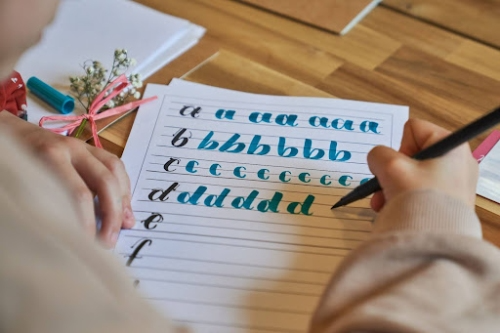How to Write in Cursive: A Beginner's Step-by-Step Guide
- Admin
- 20-Dec-2023
Introduction
Learning the art of cursive writing transcends mere aesthetics; it is a practical skill with tangible benefits that extend beyond pen and paper. In this comprehensive guide, we will delve deeper into the practical significance of cursive writing, explore its concrete advantages, and provide a detailed step-by-step roadmap to master this valuable skill.
Table of Contents:
- Cursive Writing: A Practical Workout
- Cursive Writing in 10 Steps: A Practical Guide
- Cursive Writing Tips
- Further Insights into Cursive Writing
- Fundamental Tools for Learning Cursive Writing
1. Cursive Writing: A Practical Workout

What is Cursive Writing?
Cursive writing is not just about the formation of letters; it's a practical workout that facilitates a seamless flow of words in written communication. The intricate curves and loops involved in cursive letters contribute to building stronger connections in the brain, resulting in improved memory recall and enhanced cognitive agility.
Practical Benefits of Cursive Writing
Beyond the common perception of cursive as a decorative form of writing, it offers practical advantages. These include heightened cognitive development, improved handwriting skills, enhanced reading comprehension, and the cultivation of patience and focus.
2. Cursive Writing in 10 Steps: A Practical Guide

Familiarize Yourself with Basic Strokes
Commence your cursive writing journey by acquainting yourself with basic strokes. Practice upward lines, curves, and loops to add character and fluency to your writing.
Start with Lowercase Letters
Mastering lowercase letters is fundamental as they constitute the majority of written words. Focus on the correct formation of each letter, maintaining consistent size and proportions.
Learn Uppercase Letters
Expand your skills by delving into uppercase cursive letters. Practice individual uppercase letters, paying attention to ligatures like "th," "ch," and "sh" to enhance familiarity.
Practice Letter Connections
The art of cursive lies in smooth letter connections. Focus on creating transitions that eliminate disjointedness and disrupt the natural flow of writing.
Form Basic Words
Combine individual letters to form basic words. Emphasize consistent size, slant, and spacing to ensure a smooth and coherent execution.
Advance to Longer Sentences
Progress to writing longer sentences by connecting words seamlessly. Pay attention to letter size, slant, spacing, and introduce punctuation for increased coherence.
Explore Ligatures
Enhance the artistic appeal of your cursive writing by exploring ligatures. Form seamless connections between specific letter pairs, adding a touch of sophistication to your writing style.
Develop a Consistent Slant
A consistent slant is crucial in cursive writing. Employ guide lines to maintain a uniform slant across all letters, ensuring visual appeal and professionalism.
Experiment with Flourishes
Add flair to your cursive writing with strokes and loops. Thoughtfully practice simple flourishes to infuse a unique and personalized touch to your writing.
Practice Regularly
Consistent practice is the key to mastering cursive writing. Dedicate time daily, revisiting foundational strokes, letters, and words to address any challenges and reinforce muscle memory.
3. Cursive Writing Tips

Use Guided Worksheets
Whether you are a beginner or refining your cursive skills, guided worksheets offer step-by-step guidance in learning letter formation, connections, and overall script aesthetics.
Pay Attention to Spacing
Effective spacing is crucial in cursive writing. Maintaining adequate space between words enhances readability and contributes to the overall visual appeal of your writing.
Seek Feedback
Strive for constructive feedback to improve your cursive writing skills. Solicit opinions from trusted individuals, be it friends, family, teachers, or mentors, to gain an objective overview of your progress.
4. Further Insights into Cursive Writing

Writing Faster and Better
One of the practical advantages of cursive writing is its efficiency. Individuals proficient in cursive can express themselves more quickly on paper, allowing them to focus on creating cohesive and readable compositions.
Getting More Creative
Engaging both sides of the brain, cursive writing is not just logical; it's creative. It enhances memory and linguistic skills, fostering the generation of fresh ideas and creative thinking.
Memory Retention
Cursive writing's unique flow aids in better memory retention. The distinctive way in which letters connect may contribute to an improved ability to recall information.
5. Fundamental Tools for Learning Cursive Writing
Mastering cursive requires minimal tools, emphasizing the practical nature of this skill:
- Paper
- Pencil or Pen
- Cursive Guides
Conclusion
In conclusion, mastering cursive writing is a journey toward practical proficiency. This guide advocates for recognizing its utilitarian value—improving cognitive skills, refining handwriting, and fostering focus. The seamless flow of cursive letters serves not only as a memory aid but also as a creative avenue for self-expression. Whether you're a novice or honing existing skills, the step-by-step approach outlined, along with tools like guided worksheets, underscores the simplicity and applicability of this skill. Beyond the conventional view of penmanship, cursive writing becomes a valuable, efficient tool in daily communication, weaving practicality into the fabric of self-expression and cognitive development.
Discover excellence in education at Mount Olympus School
Best School in Gurugram

Related Blogs
- Beyond Textbooks: Innovative Teaching Methods at Mount Olympus School
- Global Outlook, Local Roots: The Advantages of an International Education at Mount Olympus School
- Importance of Preschool Reading: Components, Books and More
- What are the Appropriate School Activities for Preschoolers?
- A Deep Dive into the 10 Best Active Learning Strategies at Mount Olympus School
- Air Quality Alerts: Keeping Children Safe on High Pollution Days
- The Impact of Air Pollution on Education in Gurugram
- How to Choose the Best Pre-Primary School for Your Child
- How to Choose the Best CBSE School for Your Child
- Exploring the State-of-the-Art Infrastructure at Mount Olympus School in Sector 79, Gurgaon
- Building Strong Foundations: The Importance of Preschool Education in Gurgaon
- Choosing the Best Preschool in Gurgaon: A Guide for Parents
- Unlocking Excellence: The Journey of Mount Olympus School, the Best School in Gurgaon
- How Mount Olympus Juniors School in Sector 57, Gurugram Nurtures Young Minds
- Promoting a Happy and Safe Learning Environment Mount Olympus School in Gurgaon
- Discover the Exemplary Pre-Nursery Education at Mount Olympus School, Gurgaon
- Parents tend to switch schools in July: solution Mount Olympus School, sector 79
- Career Guidance: Choose the Right Career for Happiness in Life
- Parents are a Childs best Friend
- Should children be allowed to dream?
- Self Improvement By Harshit Chawla VII
- Mosmun 2.0
- Why it is Important to teach your children about self love?
- Why Co-scholastic activities are important in a students life?
- How to Choose a School for your child?
- Why Discipline is Important in a Students Life?
- Best Dussehra Celebrations
- MOS Ki Diwali
- Gurpurab
- Vaccination Drive For Students
- Should I praise my child?
- Significance of Primary Education
- Fostering Self Esteem in the Child
- Rocksport Adventure Camp
- Preparing your child for school
- Parenting
